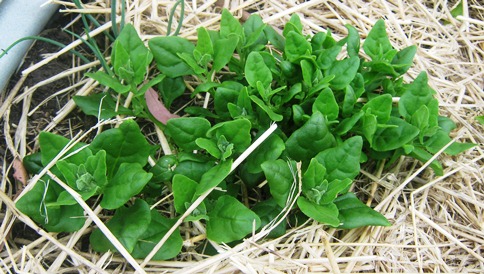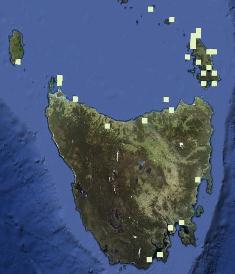New Zealand Spinach or Warrigal Greens

Tetragonia tetragonioides is a fast growing coastal groundcover that will spread to 2m or more across. It has thick, fleshy leaves, and small, yellow flowers. It grows naturally in sand dunes or other well-drained positions. Tetragonia tetragonioides has a long history of European use. It was used by early French and English explorers as an important food source, and is reputed to have saved Cook's1770 Endeavour voyage in NZ from the ravages of scurvy. The French explorers who spent considerable time at Recherche Bay in Southern Tasmania are also known to have eaten the plant. Both the English and French explorers took seeds home, and the species was soon introduced into cultivation in Europe, where it is still grown as a green vegetable. For a long time Tetragonia tetragonioides was the only food plant available in Europe to have come from Australia or New Zealand. Interestingly, there is little record of indigenous populations using it either in Australia or New Zealand.
In the garden
Tetragonia tetragonioides is suited either to growing as a vegetable in the vegie garden, or as a groundcover in well-drained, dryish conditions. Like most Australian natives it doesn't have a high nutrient demand, so planting after legumes should be avoided. It prefers full sun - excess moisture and shade can result in problems with mildew. Tetragonia tetragonioides is also suited to frontline coastal dune plantings, where it will help to bind the sand and prevent erosion.
In the nursery
We sell Tetragonia tetragonioides in 75 mm tubes for $3.25. It is such a fast growing species that we tend not to pot on it on, but can do so if required. The plants for sale are located in out bushfoods and coastal sections.
In the kitchen
A quick search on the internet will provide many recipes for using Tetragonia tetragonioides
in the kitchen. (See here for an example.) One thing to be aware of: older leaves in aprticualr can have high levels of oxalate, a chemical that is responsible for kidney stones. Rhubarb and spinach also have high levels of oxalate. It is recommended that if you are going to use older leaves that they are blanched in hot water for a few minutes prior to use to extract out the oxalates. Young leaves appear to be less of a problem.
Relationships and names
Tetragonia tetragonioides is a member of the largely South African Aizoaceae family, which inTasmania also includes Native Pigface and some other fleshy coastal plants. 'Tetragonia' liteally means 'four-angled' and refers to the shape of the fruit. 'Tetragonioides' suggests that the plant is like a Tetragonia (this apparent absurdity stems from the plant originally being described (in 1781) as being in a different genus, and when it was shifted into Tetragonia the species name had to be retained). There is one other species of Tetragonia in Tasmania, Tetragonia implexicoma. This species has smaller leaves, flowers on distinct stalks, and scrambles up and over other vegetation. The leaves of this species are also edible. Tetragonia implexicoma is also available in the nursery. One thing to note: the species is often referred to as Tetragonia tetragonoides. Even the botanists appear a little unsure as to which one is correct.
Distribution
Tetragonia tetragonioides has a scattered distribution on mainland Tasmania, being recorded from Rechereche Bay in the south to Stanley. It is more common on the Bass Straight Islands. On the mainland it has a coastal distribution in the SE, but, interestingly, penetrates into the dry interior in SA and Queensland. It also grows in New Zealand, and has become naturalised in some other countries.
Where to see it in the wild
The plant we collected material from to start propagating in the nursery is no longer present (it is now a parking lot). Tetragonia tetragonioides has been recorded at both ends of Carlton Beach in SE Tasmania, but will be hard to find amongst the extensive stands of Tetragonia implexicoma. If you know of a good place to see it, please contact the nursery.


Left: Close-up of the small flowers of Tetragonia tetragonioides (photo copyright G. Jordan)
Right: Recorded distribution of Tetragonia tetragonioides in Tasmania.
Map derived from the Natural Values Atlas
Links
Australian distribution
Key to Tasmanian Flora entry
Photos of Tetragonia tetragonioides in Flickr
Wikipedia entry
Tasmanian Flora Online - detailed scientific description